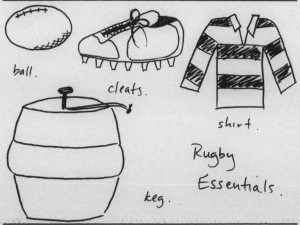I am using my thesis on the Horned Toads, the Bryn Mawr-Haverford women’s rugby team, as a starting point for this project. For my thesis, I have interviewed 16 current and former Horned Toads players about their experiences, had informal conversations with the current athletics director and head athletic trainer about their experiences working with the team, and researched the team’s history in the Bryn Mawr College archives. However, at the end of the day, all of this research putting together a history that isn’t comprehensively documented anywhere else isn’t going to be seen by many people–just me, my advisor and second reader, and whoever I choose to send it to. I think, though, that the history of the Horned Toads is a relevant history for Bryn Mawr College to grapple with publicly. Even though most students don’t play on the Horned Toads, the team has been prominent in Bryn Mawr culture throughout most of its history (arguably up until about the time any of us started at Bryn Mawr), to the point where one of my interviewees from the late 2000s said that Bryn Mawr during her time there had three social institutions: Radnor, the Pems, and rugby. Additionally, thinking about the history of the Horned Toads as a case study is a valuable way to interrogate larger questions that I think are relevant for Bryn Mawr’s campus history. First, I think it’s important to think about the role of athletics at our DIII women’s college, where athletics often receive little attention. What can be gained from centering an often-silenced part of Bryn Mawr’s history? Additionally, what does looking at the history of rugby at Bryn Mawr illuminate about larger ideas about women and sports? Second, I think that looking at the history of the rugby team is a valuable way to get at questions of the tensions between what I’ve begun to term student agency and administrative oversight. The Horned Toads’ history, as I find in my thesis research, has been defined by two main trends–desiring and actively working for greater institutionalization into the athletics department, and resisting restrictions put upon the team by the athletics department. What can understanding the history of the Horned Toads in this way illuminate about larger patterns of student-administrator interaction at Bryn Mawr, and how student agency is promoted and/ or limited in other spaces?
I see Erin Bernard’s history truck as a model for this project. I want this public history project about the Horned Toads to be truly created by community members, not just available for them to see. I would want to invite all members of the Bryn Mawr community to participate in oral history interviews and contribute artifacts related to the team–this way, I hope to put together a picture of the Horned Toads’ history that isn’t just from team members’ perspectives, but explores how the team has interacted with all aspects of Bryn Mawr life. I also want to think through the potential of objects (Schiavo) and places (Hayden) as ways of exploring the Horned Toads’ changing institutionalization. In some ways, it’s possible to represent the team’s history through spaces and objects they gain access to or lose. Prior to the 2000s, the team practiced on Haverford’s dedicated rugby field, but then Haverford decided that they needed the field for something else and took it away–now the team practices on the field behind the Graduate School of Social Work, which they have to share with local kids’ football teams. When the Horned Toads became more institutionalized into the Bryn Mawr athletics department in the mid-2000s, they gained access to spaces they hadn’t been able to utilize before, such as the trainer’s room. This institutionalization also brought access to objects that signify athletic status on Bryn Mawr’s campus–the green Gatorade water bottle and athletics t-shirts–and gained the team access to the athletics banquet where, like the varsity athletes, they are given gifts to commemorate their athletic involvement. However, access to these objects and spaces normally afforded only to varsity athletes doesn’t signify complete institutionalization for the Horned Toads (they are still not a varsity team and don’t have access to all athletics resources), so I’m interested in exploring the potentials and limitations of objects and places as representations of social changes.
For my image for this post, I chose a picture of a comic about the rugby team printed in the September 1987 issue of the College News (less than a year after the team’s founding). The comic prompted the entire team to write a letter to the editor, published in the next issue of the College News, simultaneously objecting to the team being portrayed as all about drinking and defending their right to drink after a game and still be considered athletes. Tensions over alcohol consumption as part of athletic practice have been central to the Horned Toads’ relationship with the athletics department, and also get at larger questions about the role of alcohol and sport in constructing hegemonic masculinity. I see this comic as simultaneously representative of student perceptions of the Horned Toads and the Horned Toads’ struggle for institutionalization over its 30 year history.
